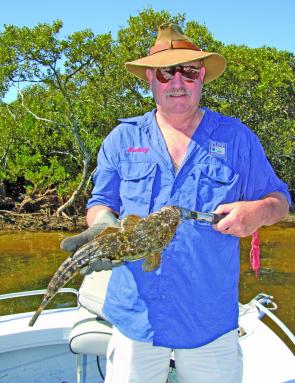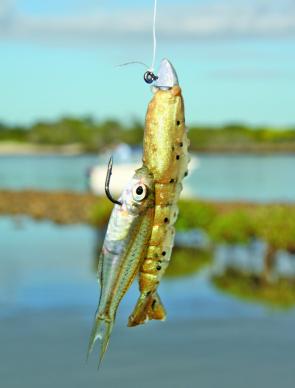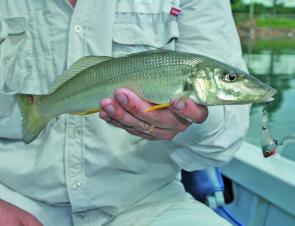I haven’t seen so much baitfish activity inside the bay for years and we can probably put that down to the shake-up the system received from all the rain earlier this year.
With all the bait, most estuary species have gone nuts and it’s not hard to find a willing candidate.
Bream fishing is sensational and I have to admit I’m going back to my old ways of throwing soft plastics.
Many of the rock walls licked by tidal influence are areas of choice and it’s been a matter of lobbing a plastic, especially a 2” Gulp Shrimp, down the face of the rock wall and hanging on.
The water has been clear and fluorocarbon leaders from 2lb to 6lb are necessary.
Surface lures and shallow-running hardbodies will also be worth a go on the shallow flats, where bream numbers will increase with rising water temperatures.
By now water should be hovering around 22° and becoming warmer day by day, especially in the shallows.
Sand and weed flats around Lemon Tree Passage, Tilligerry Creek and the back of Soldiers Point will all hold fish.
Sand whiting will be in the same areas and are now well and truly attacking surface lures.
The key is time and tide.For traditionalists, soaking live worms or nippers will definitely have some big elbow-slapping whiting queuing up. Light fluorocarbon leaders will tempt those wary larger whiting to bite.
It seems that dusky flathead have appeared from nowhere and are out in force all over the bay.
On recent trips I have found flathead lying on the flats, the edges of rock walls and basically everywhere in between. Plenty of smaller fish between 30cm and 60cm have been the mainstay with the occasional larger female appearing.
With the clear water, a stealthy approach is needed and the longer the cast, the better.Soft plastics and ganged pilchards are the go while the shallow-running Bomber lures are also deadly.
Beach fishing has been getting better with the odd quality tailor turning up at the northern end of Fingal and at Box Beach. The same areas will also produce school mulloway and with the water warming, sand whiting will also be on the cards.
The rock fishing scene has been a little slow with tailor and salmon the main encounters, whilst smaller snapper have been eager to take floating baits around Rocky Point and Boat Harbour.
Some great kingfish action has been occurring around the islands with live baits slowly trolled around the washes producing better numbers.
Although not huge, most fish have been around 3kg to 8kg. Try the front of Fingal or the eastern side of Little Island.
Squire can be caught drifting along the edges of the reefs withOn the continental shelf there has been the odd striped marlin but as the month progresses, things should turn around with blacks and blues starting to show.
Bait schools have been prevalent, which is a good sign, but when the current starts to howl you will find that the bait will go with it.
Reads: 7300
Plenty of flathead have appeared up and down the Port Stephens estuaries. Local angler Dave Glynn has been successfully targeting duskies on fly.

Baitfish numbers have exploded in the estuary this Spring. This little guy took a liking to a Gulp Shrimp. Is there nothing that won’t eat a gulp shrimp?

Break out the surface poppers! Sand whiting are aggressive fish, this one snaffling the ever faithful Rebel Pop-R, a classic popper for whiting.




